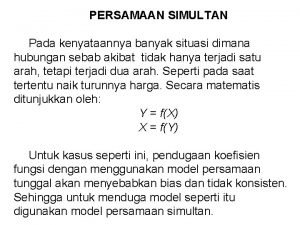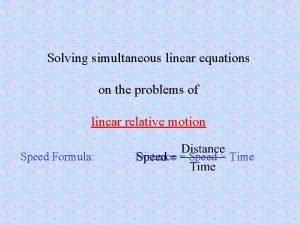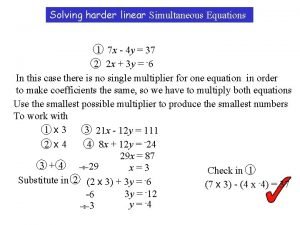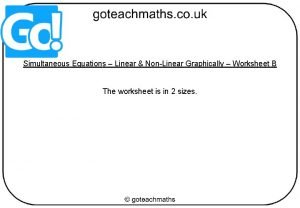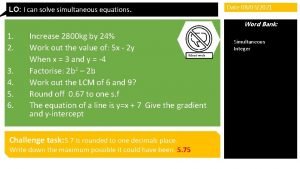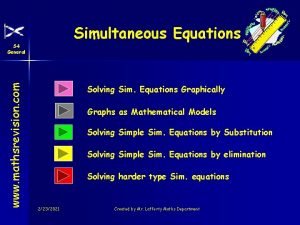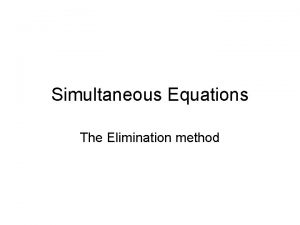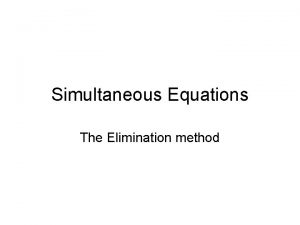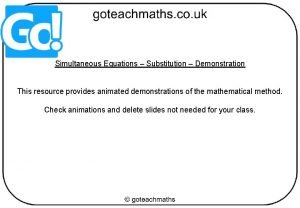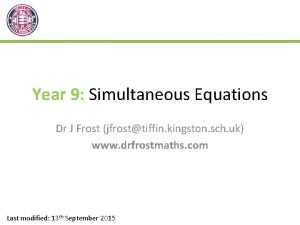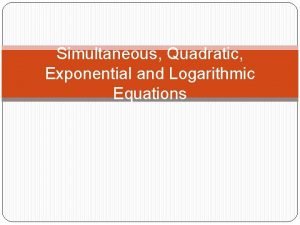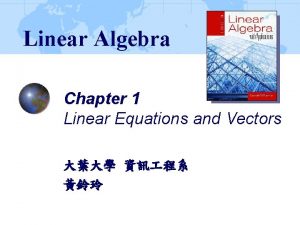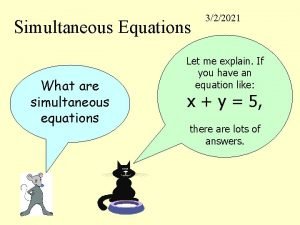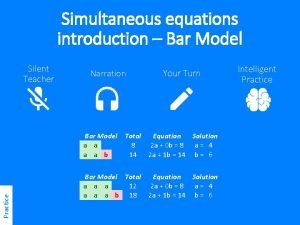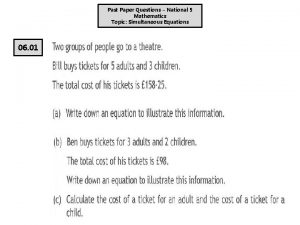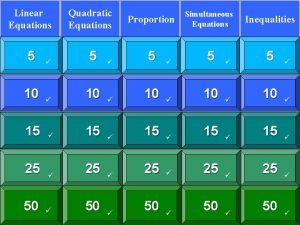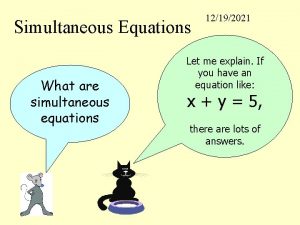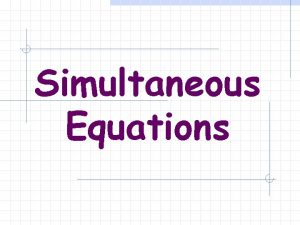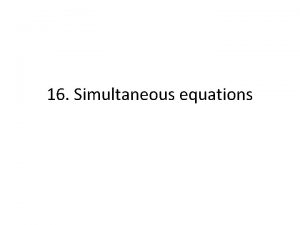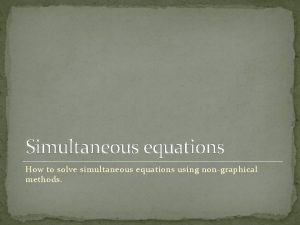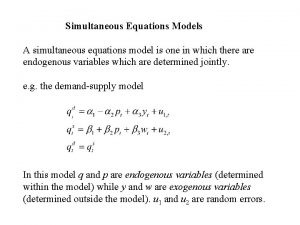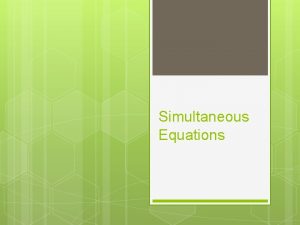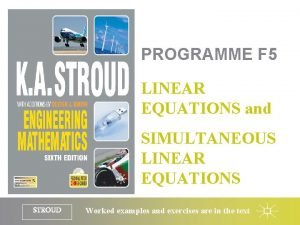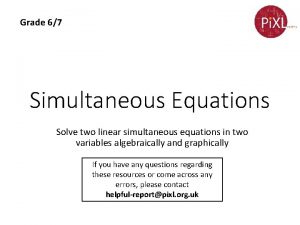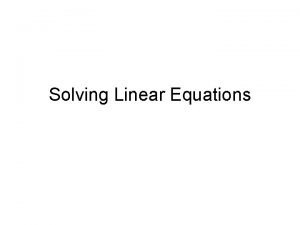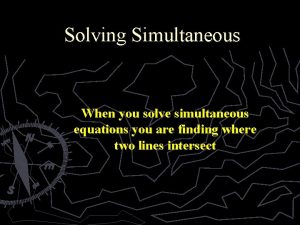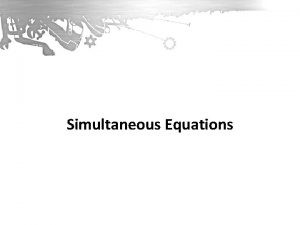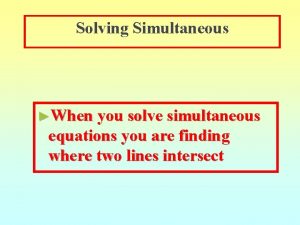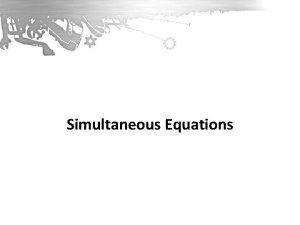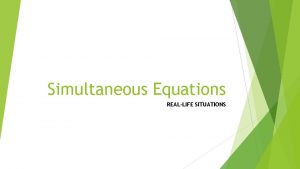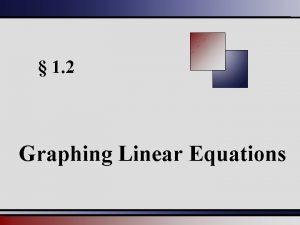PROGRAMME F 5 LINEAR EQUATIONS and SIMULTANEOUS LINEAR



















- Slides: 19

PROGRAMME F 5 LINEAR EQUATIONS and SIMULTANEOUS LINEAR EQUATIONS STROUD Worked examples and exercises are in the text

Programme F 5: Linear equations and simultaneous linear equations Linear equations Simultaneous linear equations with two unknowns Simultaneous linear equations with three unknowns STROUD Worked examples and exercises are in the text

Programme F 5: Linear equations and simultaneous linear equations Linear equations Solution of simple equations A linear equation in a single variable (unknown) involves powers of the variable no higher than the first. A linear equation is also referred to as a simple equation. The solution of simple equations consists essentially of simplifying the expressions on each side of the equation to obtain an equation of the form: STROUD Worked examples and exercises are in the text

Programme F 5: Linear equations and simultaneous linear equations Linear equations Simultaneous linear equations with two unknowns Simultaneous linear equations with three unknowns STROUD Worked examples and exercises are in the text

Programme F 5: Linear equations and simultaneous linear equations Simultaneous linear equations with two unknowns Solution by substitution Solution by equating coefficients STROUD Worked examples and exercises are in the text

Programme F 5: Linear equations and simultaneous linear equations Simultaneous linear equations with two unknowns Solution by substitution A linear equation in two variables has an infinite number of solutions. For two such equations there may be just one pair of x- and y-values that satisfy both simultaneously. For example: STROUD Worked examples and exercises are in the text

Programme F 5: Linear equations and simultaneous linear equations Simultaneous linear equations with two unknowns Solution by equating coefficients Example: Multiply (a) by 3 (the coefficient of y in (b)) and multiply (b) by 2 (the coefficient of y in (a)) STROUD Worked examples and exercises are in the text

Programme F 5: Linear equations and simultaneous linear equations Linear equations Simultaneous linear equations with two unknowns Simultaneous linear equations with three unknowns STROUD Worked examples and exercises are in the text

Programme F 5: Linear equations and simultaneous linear equations Simultaneous linear equations with three unknowns With three unknowns and three equations the method of solution is just an extension of the work with two unknowns. By equating the coefficients of one of the variables (OR by using the substitution method – John Barnden) that variable can be eliminated to give two equations in two unknowns. These can be solved in the usual manner and the value of the third variable evaluated by substitution. STROUD Worked examples and exercises are in the text

Simultaneous linear equations with three unknowns (x, y, z), contd (added by John Barnden) METHOD in more detail: There will now be THREE EQUATIONS, not two, each involving ALL THREE VARIABLES. Take any two of the equations. Eliminate one of the variables, say z , using either the substitution method or the equating-coefficients method. So you now have created a new equation, involving only x and y. Do the same with a different pair of the original equations. So you now have another new equation, involving only x and y. Solve your two new equations for x and y, using the method for two variables. Now use any one of the original equations to find the value of z. STROUD Worked examples and exercises are in the text

Simultaneous linear equations with three unknowns (x, y, z), contd (added by John Barnden) EXAMPLE (from textbook p. 193, to be worked through in class): 3 x + 2 y – z = 19 4 x – y + 2 z = 4 2 x + 4 y – 5 z = 32 STROUD Worked examples and exercises are in the text

Simultaneous linear equations with three unknowns (x, y, z), contd (added by John Barnden) EXERCISE: How would you proceed if (a) only two of the equations used all three of x, y, z, the other equation using only one of them (b) only one of the equations used all three of x, y, z, the other two equations using only x and y (c) one of the equations used all three of x, y, z, another uses just x and y, and the third uses just y and z. STROUD Worked examples and exercises are in the text

Programme F 5: Linear equations and simultaneous linear equations Simultaneous linear equations Pre-simplification Sometimes, the given equations need to be simplified before the method of solution can be carried out. For example, to solve: Simplification yields: STROUD Worked examples and exercises are in the text

Back to Simultaneous linear equations in TWO unknowns STRAIGHT LINE VIEW (ADDED by John Barnden) A linear equation in two variables can be viewed as defining a straight line. Suppose we have Dx + Ey = F Solve for y, to get: y = – (D/E)x + F/E But when you graph this you get a straight line …. . STROUD Worked examples and exercises are in the text

Programme 8: Differentiation applications 1 (NB: from a different part of the book) Equation of a straight line The basic equation of a straight line is: where: When m is negative, the line slopes downwards. (ADDED by JAB) m is also called the slope. STROUD Worked examples and exercises are in the text

Back to Simultaneous linear equations in TWO unknowns STRAIGHT LINE VIEW, contd So if we have two linear equations in x and y: Dx + Ey = F Gx + Hy = J we get two straight lines: y = – (D/E)x + F/E y = – (G/H)x + J/H And their intersection is at the x and y values that solve the original equations (Why? ). STROUD Worked examples and exercises are in the text

Back to Simultaneous linear equations in TWO unknowns STRAIGHT LINE VIEW, contd If we have two straight lines: y = mx + c y = nx + d We can find the x value at the intersection by solving those simultaneous equations, most easily by eliminating y: mx + c = nx + d So: x = (d-c) / (m-n) [provided m and n are unequal] Now we can also find the y value, from either of the equations. STROUD Worked examples and exercises are in the text

Back to Simultaneous linear equations in TWO unknowns STRAIGHT LINE VIEW, contd We had the following earlier: Dx + Ey = F Gx + Hy = J From which we got: y = – (D/E)x + F/E y = – (G/H)x + J/H So “m” is –D/E and “n” is –G/H. So we can solve if and only if D/E G/H, i. e. DH – EG 0 DH – EG is called the determinant of the original pair of equations. So you can test whether or not the equations can be solved by seeing whether or not the determinant is non-zero. (See textbook Prog 4 for optional extra material on determinants. ) STROUD Worked examples and exercises are in the text

Simultaneous equations need not be linear! (added by John Barnden) Could for instance have a linear equation and an equation involving squares: Dx + Ey = F Ax 2 + Bxy + C y = J Here we could use the substitution method. Solve the first equation of y and then use the answer in the second equation. (EXERCISE) STROUD Worked examples and exercises are in the text
 Persamaan linear simultan
Persamaan linear simultan How to solve non linear simultaneous equations
How to solve non linear simultaneous equations Persamaan situasi
Persamaan situasi Linear simultaneous equations
Linear simultaneous equations Harder simultaneous equations
Harder simultaneous equations Simultaneous equations worksheet
Simultaneous equations worksheet Persamaan non linier metode numerik
Persamaan non linier metode numerik X^2+y^2
X^2+y^2 Simultaneous equations step by step
Simultaneous equations step by step Simultaneous equation by elimination method
Simultaneous equation by elimination method Simultaneous equation by elimination method
Simultaneous equation by elimination method Simultaneous equations
Simultaneous equations Sistem persamaan linear
Sistem persamaan linear Dr frost simultaneous equations
Dr frost simultaneous equations Quadratic exponential equations
Quadratic exponential equations Inequality brackets
Inequality brackets Chapter 1 solving linear equations
Chapter 1 solving linear equations Substitution
Substitution Simultaneous equations introduction
Simultaneous equations introduction As past paper
As past paper


